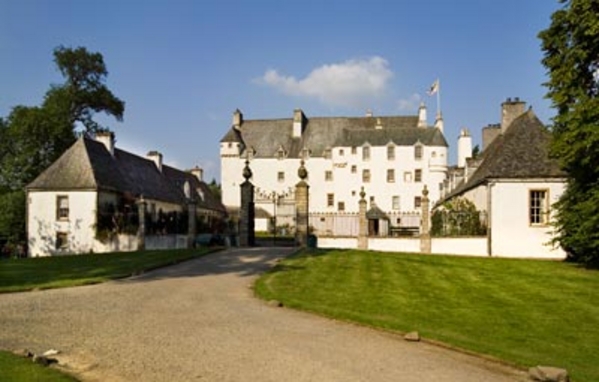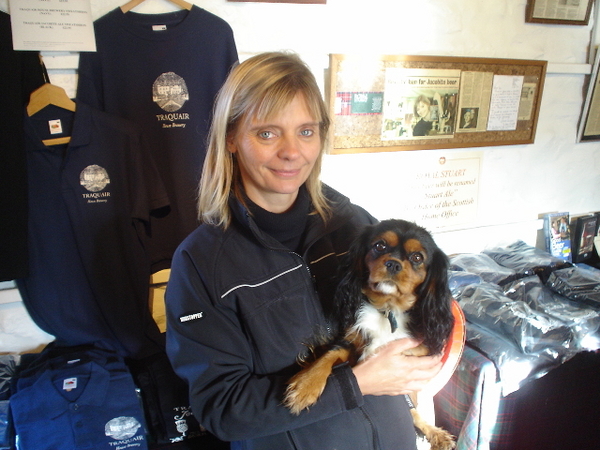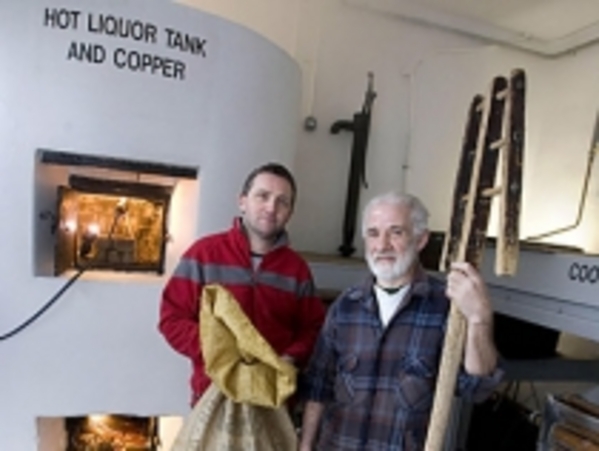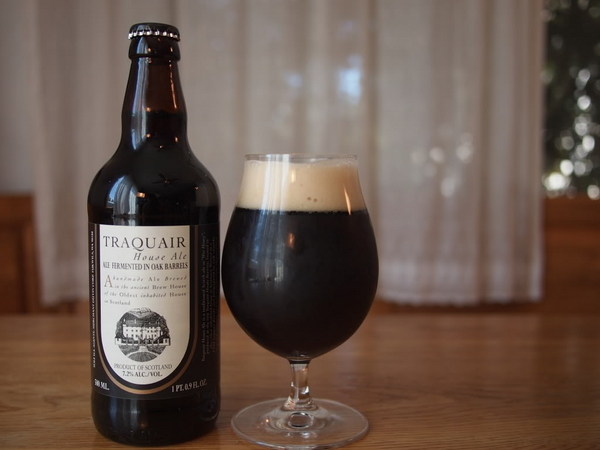Unlocking the gates to Traquair historic ale
Added: Tuesday, August 5th 2014

You tip-toe around Traquair House with due reverence for the age and the turbulent history of Scotland’s oldest inhabited house that dates from 1107. Great oak doors and wood floors creak while winding stone stairs take you to spacious rooms where the kings of Scotland once dined and slept.
Mary Queen of Scots stayed here with her small son who became James VI of Scotland and James I of a united Great Britain. Mary was unsuccessful in her attempt to oust Elizabeth I from the throne and paid with her life. Prince Charles Edward Stuart – Bonnie Prince Charlie – called at the house to raise support for his equally unsuccessful campaign to win back the crown.
Traquair is owned by a branch of the Stuart clan, the Maxwell Stuarts, and they closed and barred the main Bear Gates on the estate following the failure of the 1745 rebellion: they will remain locked until a Stuart once again sits on the throne. Such small matters as the longevity of the House of Windsor, the possibility of Scottish independence and the Stuarts’ Catholicism suggest it may be some time before this hope is fulfilled.
The Maxwell Stuarts keep themselves busy. They have opened the house – with its magnificent libraries, oil paintings of monarchs and earls, and Mary’s artefacts and letters – to the public. Accommodation is provided in luxurious apartments and weddings, concerts and festivals are regularly staged.

And they brew beer. And what beer it is! It brings a whole new meaning to the term “real ale”, brewed in an 18th century brewhouse, one of the oldest in Britain, and using simple techniques that haven’t changed over the ensuing centuries.
The brewhouse is in a stone building alongside the Quair, a winding burn that’s runs through dense woods where deer run until it meets the River Tweed, the watery border with England. The brewery was originally based in the kitchen and made beer for the family, their servants and visitors. The 18th-century equipment hadn’t been used for more than 100 years when Peter Maxwell Stuart, the 20th laird or lord of Traquair, decided to resume brewing in 1965.
With the energetic support of Sandy Hunter, the legendary head brewer at Belhaven in Dunbar, Peter got the equipment back into working order: it's managed today by brewers Ian Cameron and Frank Smith (pictured). It comprises a wooden mash tun, underback, copper and cooling trays. The underback is a receiving vessel that holds the wort or sweet extract following the mash and prior to the boil in the copper with hops.
The “hopped wort” rests in the open cooling trays while it reaches a temperature suitable for fermentation. It’s then pumped to the Tun Room next door where it’s vigorously mixed with yeast in large oak vessels known as rounds.
Primary fermentation takes five days. The beers are then conditioned for between four and six weeks before bottling: bottling is carried out for Traquair by Robinson’s of Stockport.
Peter and Sandy researched old documents in the archives and devised a recipe for House Ale that, at 7.2 per cent alcohol, belongs to an old Scottish style known as a Wee Heavy – similar to an English barley wine. Malt comes from Scottish barley, with soft brewing liquor drawn from a spring on site that’s fed with water from the surrounding Pentland hills. The yeast culture came first from Belhaven, then from Scottish & Newcastle’s Fountainbridge Brewery in Edinburgh. S&N and Fountainbridge no longer exist and Traquair now uses dried yeast.

Hops are the only foreign ingredient: East Kent Goldings from South-east England. Hops once grew at Traquair but as the climate changed they died out in the 18th century.
At first Peter Maxwell Stuart brewed only small batches of beer on an occasional basis. But interest was aroused in the 1970s when Traquair was discovered by the Campaign for Real Ale and sales grew south of the border as well as in Scotland. When Michael Jackson mentioned Traquair House Ale in his World Guide to Beer, demand started to come from the United States and several other countries.
Peter Maxwell Stuart died in 1990 and his daughter Catherine (above) gave up a career in the theatre to join her mother Flora in running the house and brewery. The brewery has thrived with the addition of a 5.2% Bear Ale sold on draught as well as in bottle and Jacobite Ale (8%), spiced with coriander, first brewed in 1995 to celebrate the 250th anniversary of the 1745 rebellion. A 6% Laird’s Liquor is also occasionally brewed, with a dash of liquorice added to the malt and hops.
The brewery produces 1,000 hectolitres a year, which translates into 250,000 bottles. Production is made up predominantly of House Ale and Jacobite: the U.S. now takes more Jacobite than the original beer. The beers are also exported to Brazil, Chile, Finland, France, Italy, Japan and Sweden. In Scotland, Traquair beers are sold by Aldi and Waitrose as well as specialist shops.
Catherine would like to build sales south of the border but is constrained by the capacity of the brewery and a second micro-plant has been added next to the tun room to augment production.
I said I found a tart and slightly acidic note in the beers, House Ale in particular, and wondered if the open coolers attracted wild yeast in the manner of Belgian lambic. Catherine denied this and said production in the new micro plant was in enclosed vessels which wild yeasts couldn’t permeate.
It’s more likely that the tart, oaky note comes from fermentation in wood and the Traquair beers have more in common with another Belgian style – “sour red” – than lambic.
What is beyond dispute is that visitors and residents centuries ago would have enjoyed the house’s ale. Mary Queen of Scots, when she was held prisoner at Tutbury Castle in Staffordshire, was sent supplies of ale by a brewer in nearby Burton-on-Trent and she would surely have relished the ales in the more congenial surroundings of Traquair House.

The beers
Traquair House Ale (7.2%)
Just 1% of black malt is added to pale. The hops create 34 units of bitterness and the tawny colour of the beer is the result of some caramelisation of the brewing sugars during the copper boil. The beer has a rich aroma of marmalade fruit,chocolate and peppery hops. Orange, lemon and lime fruits fill the mouth, with nuts, chocolate and hop resins. The finish has warm alcohol, tart fruit, nuts and a lingering hop note.
Jacobite Ale (8%)
This stronger version of the House Ale has an addition of coriander. It has a pronounced oak and smoked aroma with hints of chocolate, liquorice, vanilla, peppery hops and a herbal note from the coriander. There's rich dark grain in the mouth with bitter hops developing, with continuiing notes of chocolate and coriander. The finish is bittersweet with dark grain, raisin fruit and peppery hops.
Bear Ale (5%)
The only beer available in cask as well as bottle, it's a lower strength version of House Ale but with a robust 34 units of bitterness. It has a rich malt aroma balanced by marmalade fruit and peppery hops, with tart fruit, biscuit malt and hop resins in the mouth and a hint of chocolate and cobnuts. The finish is fruity and bittersweet, with tart fruit, peppery hops and a continuing note of chocolate.
*Traquair House and brewery are open to visitors and the bottled beers can be bought online.
www.traquair.co.uk/www.traquair-house-brewery.co.uk






